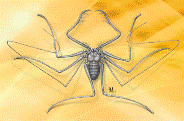Papers in the Biological Sciences

Eileen Hebets Publications
Document Type
Article
Date of this Version
11-2014
Citation
Teaching and Outreach Module, Funded by NSF.
Abstract
This program was funded in part by a National Science Foundation grant (DRL–1241482 to EAH). Material was developed in collaboration with Marie- Claire Chelini, Jessie Rose Storz, Cody Storz, and Malcolm Rosenthal. Steven Schwartz, Jason Stafstrom, Kathy French, Priscilla Grew, and Judy Diamond were all extremely helpful in grant writing, facilitating the first live event, and/or discussions. Pawl Tisdale (artist) was phenomenal to work with on all aspects of the project!
TABLE OF CONTENTS
CLASSIFICATION & TAXONOMY STATIONS
I. WHAT IS AN ARTHROPOD? page 4 a. The goal of this station is to introduce the audience to some basic information about “arthropods”. Who are they? How and why are they grouped together? Answers to these questions are achieved through a sorting game with plastic animals.
II. CREATE A CHELICERATE page 14 a. This station introduces the audience to the basic characteristics of chelicerates (a group which they have learned about from Station I) by allowing them to build their own chelicerate out of clay.
III. ASSEMBLE AN ARACHNID page 16 a. Arachnids are surprisingly diverse, with 11 different living orders! This station introduces the audience to the diversity of body types found within the 11 living arachnid orders through a coloring activity.
SPIDER-SPECIFIC STATIONS (ORDER ARANEAE)
IV. BUILD A BURROW page 20 a. The first spiders didn’t build orb webs to catch prey out of the air, but instead, built silk-lined burrows with trapdoors. This station explores the early function of spider silk.
V. CRIBELLATE VS. ECRIBELLATE SILK page 22 a. Spiders have evolved two different ways to improve the efficiency of prey capture with their webs. This station explores those two evolutionary solutions.
VI. WEAVE A WEB page 24 a. Orb webs (the classical web most non-biologists envision when asked to think of a spider web) are quite complex structures. How do spiders build orb webs? Do they use the same type of silk for the entire web? Answers to these questions can be obtained as participants are guided through their own web-weaving exercise.
VII. CATCH A MOTH page 27 a. This station highlights the unique foraging strategy of the ‘bolas spider’ through a game in which participants try to catch a moth out of the air using a lasso.
VIII. TISSUE PAPER FLOWER page 29 a. This station lets the audience create their own tissue paper flower upon which their chosen crab spider (made of paper) can forage. It introduces the fact that some spiders can change color and highlights the adaptive value of camouflage.
RESEARCH-RELATED STATIONS
IX. MICROSCOPE MADNESS page 33 a. This station provides the audience an opportunity to take an up-close look at spiders - to examine body parts they cannot normally see and to get them thinking about how these details might relate to an animals’ lifestyle or evolutionary history.
X. COMMUNITY EXPERIMENT page 38 a. This station engages participants in a hand’s on spider feeding experiment that examines the influence of seismic (vibratory) cues on foraging success. Participants are encouraged to imagine how their results may relate to the evolution of courtship displays that incorporate specific sensory modalities.
MISCELANEOUS STATIONS
XI. SILKEN SPINNERS page 44 a. This station provides some “down time” for participants, where they can sit and watch the amazing footage and associated information put together by the BBC in David Attenborough’s “Silken Spinners” episode from Life in the Undergrowth.
XII. SOUND STATION page 45 a. Most people do not realize that some spiders can “sing” in the form of stereotyped vibrations that are sent through a substrate, or surface upon which they are standing (e.g. a leaf, a twig, a blade of grass, etc.). Here, participants can listen to the sounds of spiders and are asked to imagine if they might find these songs attractive.
XIII. SPIDER DANCE DISCO page 46 a. Not only can spiders sing, but they can also dance! Participants can observe some of the amazing dances that spiders do and can learn some of their own spider dance moves by watching the “Spider Dance Disco”
XIV. READ ALOUD page 47 a. This station enables participants to play with some arachnid stuffed animals, puzzles, and to look through arachnid-related children’s books. Several books are listed as suggestions for read alouds.
PATH OF PREDATORS
XV. LIVING ARACHNID ORDERS page 48 a. Araneae, Amblypygi, Thelyphonida, Schizomida, Scorpiones, Solifugae, Palpigradi, Ricinulei, Pseudoscorpiones, Acari, Opiliones
Included in
Animal Sciences Commons, Behavior and Ethology Commons, Biology Commons, Entomology Commons, Genetics and Genomics Commons


Comments
Copyright 2014 Eileen Hebets.